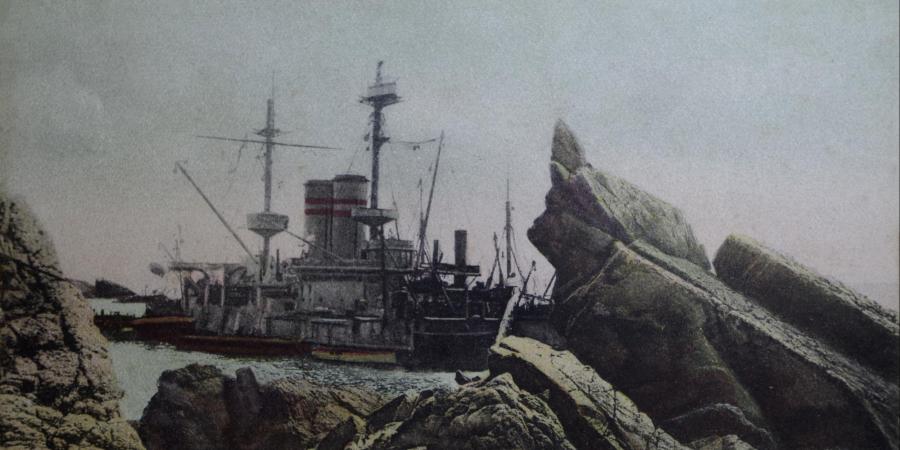We tend to think of ‘shipwreck tourists’ as being those lucky enough to dive in submarines to the wreck of the Titanic or modern recreational divers enjoying the best of what is to be found on the seabed. We envision divers exploring Red Sea reefs or using ‘dive trails’ produced by Historic England for some of this country’s most important historic wrecks. But, as Wessex Archaeology West and Coastal & Marine’s Graham Scott discussed in a public talk last week at Ilfracombe Museum, shipwreck tourism goes back much further than that.
A dramatic wreck
In May 1906 one of the Royal Navy’s finest battleships, HMS Montagu, ended up on the rocks of Lundy Island in the Bristol Channel. Dense fog and a navigational error all contributed to the disaster. The keeper of Lundy’s northern lighthouse reported that the naval officers who scrambled ashore were so lost that they were convinced that they had run aground on the mainland.
The ship was so robust that it remained intact on the rocks for three months. The Navy struggled in vain to save the valuable ship, before finally accepting that it was doomed and handing it over to professional salvors.


Images courtesy of Ilfracombe Museum
Sightseers and souvenirs
During this time, Lundy’s excursion boats plied a busy, opportunistic trade carrying visitors from the seaside resort out to see the Montagu. It must have been some spectacle; the ship stuck firm under the high cliffs of Lundy, surrounded by battleships of the Channel Fleet attempting its recovery.
Many postcards produced to sell to tourists that are now in the collection of Ilfracombe Museum. The wrecking of the Montagu was not forgotten, and these postcards seem to have been printed for many years. Alongside these, many small souvenirs were taken from the ship and given or sold by the salvors to people in Ilfracombe. Some of these are displayed in the museum, including wood salvaged from the ship that was turned into a clock case by a local clockmaker.
Continued public interest
In summer 2018, Wessex Archaeology carried out a diving survey of the Montagu as part of a Historic England expedition and a Help for Heroes Marine Operation Nightingale project.
The dive garnered a significant amount of national media interest and resulted in a ship badge from the Montagu, complete with the motto of the Order of the Garter, being donated to Ilfracombe Museum. The badge is similar to one recovered from the wreck some years ago by a member of the local diving club, Ilfracombe and North Devon Sub Aqua Club.
Until it closes for the winter period on Friday 21 December 2018, Ilfracombe Museum is open Tuesday to Friday, 10am to 1pm. Rated 4.5 out of 5 by TripAdvisor, it’s well worth a look. If you are a diver looking for an interesting historic wreck to dive at Lundy, why not try our dive trail for the Iona II, a Glasgow-built paddle steamer from the 1860s and part of Britain’s little-known contribution to the American Civil War (see the Landmark Trust website for details). The shallower but less well-preserved Montagu makes for an interesting second dive.
